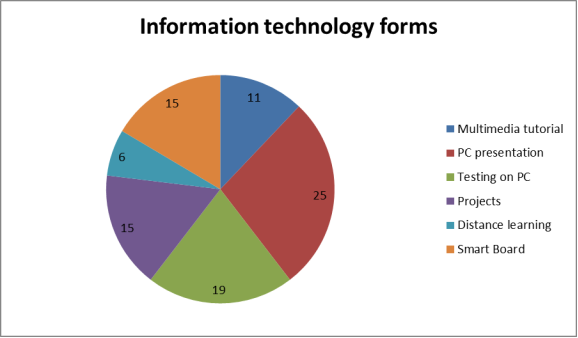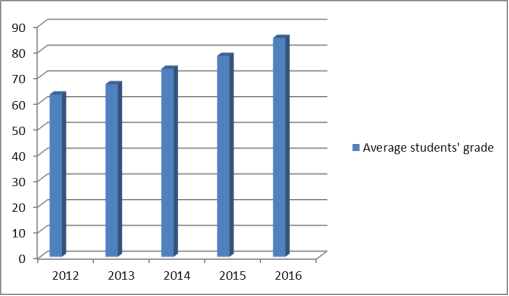In the 21st century, there is a steady trend towards a reorientation of the higher education system to new values of the pedagogical process. Today, a graduate of a higher school should be competitive and in demand on the labor market, which requires a high level of its overall development, possession of information and communication competence, high professionalism, the ability to make independent decisions, non-standard thinking and productive adaptation to changing conditions. All this leads to the fact that at present time the pedagogical activity should be innovative, which is one of the essential factors for the successful teaching of any educational institution. The reality is that the innovative activity on the one hand, creates the basis for the competitiveness of an institution in the market of educational services, on the other hand it determines the directions for the professional growth of pedagogical personnel, the creative search for each teacher that actually promotes the individual growth of students.
In this regard, in recent years, the use of information technologies in the university has become more and more widespread, representing not only modern technical means, but also new approaches to the learning process. This is can be observed as the main goal of teaching foreign languages. The task of the university teacher is to create all conditions for the practical mastery of the language by each student. This presupposes the choice of such methods of instruction that would allow him to show his creative and active skills. This is the aim of modern innovative technologies which relates to the use of various information technologies and Internet resources.
Analysis of the activities of universities in the Republic of Kazakhstan shows that today the variability principle is being developed, which contributes to the construction of the pedagogical process for any educational model. Against the backdrop of the development of various options for the content of education, we see all new ideas rise, as well as the introduction of the concept of pedagogical technology into the philosophy of education. Among a large number of definitions of this concept, we will cite the interpretation of pedagogical technology proposed by the Russian researcher B. T. Likhachev: this is a cooperation of psychological and pedagogical attitudes determining a special set and composition of forms, methods of teaching, educational approaches that form the organizational and methodological tools of the pedagogical process. Proceeding from this, among the list of various pedagogical technologies the following have most confidently passed the test of time: multilevel training; co-operative learning; individual and differentiated approach, project method. All of them contribute to the development of innovations in education, involving the improvement of pedagogical technologies and related methods and means of teaching that develop in students the ability to motivate actions and to orient themselves in the information world independently as well as the formation of their creative thinking skills and the disclosure of their natural abilities.
Pedagogical approaches are associated with a wide application of new information technologies that make it possible to fully disclose the didactic functions of these methods and realize the potential educational opportunities inherent in them. Since today the free access to the necessary information is required, information centers create all the opportunities for reaching the scientific, cultural and information centers of the whole world in order to form their own independent opinion as part of a comprehensive study of a particular problem. Thus, students should be provided with favorable conditions for using the technological capabilities of modern communication means, both for searching and receiving information, and for the development of cognitive and communicative skills. This process is most successful through the use of information and communication technologies for teaching, including specific methods and technical means such as computers, audio and video facilities, telecommunications networks, etc. This type of pedagogical technologies today is termed «computer-based learning technologies», which continue to develop the ideas of programmed instruction, opening up new technological opportunities for the learning process, connected, for example, with certain advantages of computers and telecommunications [3].
According to the latest data provided, in particular, by the Internet, at present the largest universities in Kazakhstan use as much as possible the innovative technologies in the learning process; periodically hold seminars and conferences on the innovative technologies implementation. Let us emphasize that education in universities using innovative technologies is always open to modern scientific research where the curriculum represents such forms of training as project development, training, internships in production, and participation in research organizations [4].
The main forms of using information technologies are the following:
1) multimedia tutorials, which are conducted on the basis of computer training programs;
2) lessons based on author's computer presentations during lectures, seminars, laboratory works, student reports;
3) testing on computers;
4) telecommunication projects, work with audio and video resources online;
5) distance learning, which includes all forms of educational activity, carried out without the personal contact of the teacher and student;
6) work with interactive tablets Smart Board;
7) voice chat over the local network, used to teach phonetics. So, to implement the chat, free programs;
8) linguaphone devices, which include a teaching console and student workstations, as well as equipment based on one of the following schemes: audio passive, audio-active or audio-comparative.
The following pie chart shows the popularity of different innovative technologies by foreign language department teachers at Karaganda state technical university in percentage (Fig. 1).

Fig. 1.
Audio passive devices are designed to give students the opportunity to listen to phonograms; audio-active devices allow students not only to listen to phonograms, but also to train themselves in loud speech, that is, in speaking; audio-device devices allow you to record your speech on a tape recorder, and then listen to this record and compare it with an exemplary one).
All this creates a foreign language environment in the process of teaching foreign languages, where the technical means of instruction are used. For example, computer training programs in foreign language classes allow the following forms of work: pronunciation; work on grammatical material; vocabulary expansion; writing and speaking skills development [2].
Today the priority in the search for information is increasingly given to the Internet, which provides a wide choice of sources of information, so necessary in the educational process. Hence the information resources of the Internet are organically integrated into the educational process, helping to solve various didactic tasks in foreign language classes, for example, such as:
– formation of reading skills;
– vocabulary enrichment in the studied language;
– writing skills improvement;
– listening skills improvement on the basis of original sound texts;
– acquaintance with culture, speech etiquette, features of speech behavior of the country of the studied language;
– speaking activity encouragement of the specifics of academic writing.
The following diagram shows the students foreign language final exam results increase after the innovative technologies were implemented into the teaching process for the period of 5 years (Fig. 2).

Fig 2. The students’ results increase over the 5 years period
When solving these problems, real conditions are created for students to expand their horizons, self-education, the ability to organize independent research and research work. In this regard, researcher I. G. Zakharova proposes the creation of an Internet library to facilitate the search online. However, for the effective operation of such a resource, it is important to prepare auxiliary pages containing the most valuable sources of information on the subject matter under study. Although these resources are not a learning material, they nevertheless make it possible to work on the network with authentic texts, which are a motivational source for students, and therefore can be used in the educational process. Therefore, the opportunity to see, read, listen to authentic material and then communicate with native speakers independently forms creative and critical thinking [1]. In this regard, you can offer electronic versions of newspapers, most of which have their own web pages. We can also add that online work with the newspaper provides unique opportunities for the formation of intercultural communication, when students can take part in the discussion of the problems that interest them.
Thus, the possibilities of using Internet resources are enormous, as they create the conditions for obtaining information that is necessary for students in any part of the globe, whether news from the life of young people, articles from newspapers and magazines, regional material, etc.
However, it is important to understand that each teacher regards the computer as the means of strengthening and expanding the possibilities of educational activity. The teacher in this case organizes cognitive activity of students, trying to interactively use situational models of training, creative methods, including the latest techniques (case studies, role plays, business games, dialogues, debates, seminars, conferences, abstracts, etc.), so as to solve the problems of the quality of education with the help of innovative teaching technologies.
Modern reality makes ever higher demands on the level of practical knowledge of a foreign language. In this regard, the use of innovative educational technologies provides enormous opportunities for increasing the effectiveness of the learning process. The information and multimedia training programs discussed in the article, as practice shows, have advantages over traditional methods of teaching, since they not only allow one to train certain types of speech activity, combining them in various combinations, but also contribute to the realization of an individual approach and increase the students' independence. To this we should add that the use of innovative technologies in the process of teaching a foreign language also makes it possible to improve qualitatively the overall cultural development of young people, contributing to the further improvement of their computer skills. The use of innovative technologies in teaching foreign languages carries a huge pedagogical potential, which makes it possible to transfer the language into real life.
References:
- Akhmetova D. R., Beyshanova S. A., Kogay O. A. To the development of the reading skills development at the professionally-oriented foreign language classes using the technologies of critical thinking // Young Scientist.- 2015. № 24.-P.906.
- Marie — Noelle Lamy, Regine Hampel. Online communication in language learning and teaching //New York.- 2007. — P. 112–121.
- Sandra J. Sauvignon. Communicative Language Teaching// State of the Art. -2016.№ 11. — P.48.
- Polat E. S., Bukharkina M.Yu., Moiseeva M. V., Petrov A. E. New pedagogical and information technologies in the education system: // Academy. — 2004. P.272.







